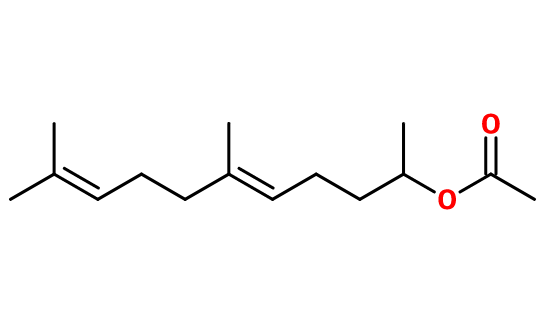
Photo credits: ScenTree SAS
Do you sell any of the raw materials? Would you like to let our users know?
Send an email to fournisseurs@scentree.coto learn about our advertising opportunities.
Do you sell any of the raw materials? Would you like to let our users know?
Send an email to fournisseurs@scentree.coto learn about our advertising opportunities.
General Presentation
-
CAS N° : 3239-35-8
-
EINECS number : 221-803-4 ; 221-803-5
-
FEMA number : Donnée indisponible.
-
Density : 0,89 @20°C
-
Optical rotation : Donnée indisponible
-
Allergens : This ingredient does not contain any allergen.
-
Refractive Index @20°C : Donnée indisponible
-
Volatility : Base
-
Price Range : €€
-
Appearance : Colorless liquid
-
FLAVIS number : Donnée indisponible.
-
JECFA number : Donnée indisponible.
Information on synthetic ingredients
-
Acid Value : Donnée indisponible
-
Boiling Point : 296°C
-
Detection Threshold : 7,8203 ng/l air
-
Molecular formula : C15H26O2
-
Log P : 5,8
-
Molecular Weight : 238,37 g/mol
-
Fusion Point : Donnée indisponible.
-
Flash Point : 131°C
-
Vapor pressure : Donnée indisponible
Uses
Other comments :
Stability :
Data not available.
Uses in perfumery :
Tangerinol is a very interesting ingredient because of its citrusy / marine / aldehydic triptych. It may be used to extend zesty, citrus notes to the heart, giving a fresh and juicy aspect. Very good in colognes and candles in particular (although it remains stable in most common applications). Its watery ozonic aspect makes it an ingredient of choice for ''sea breeze '' notes. Nonetheless, beware of the strength of this raw material. Tangerinol is also effective as a sandalwood booster in soap.
Year of discovery :
Data not available.
Isomerism :
Data not available.
Synthesis precursor :
Data not available.
Natural availability :
Tangerinol is not available naturally.
Synthesis route :
Data not available.
Regulations & IFRA
This ingredient is not restricted

